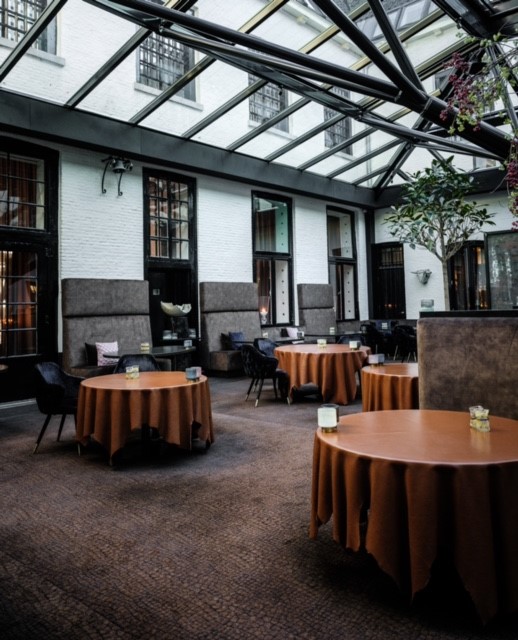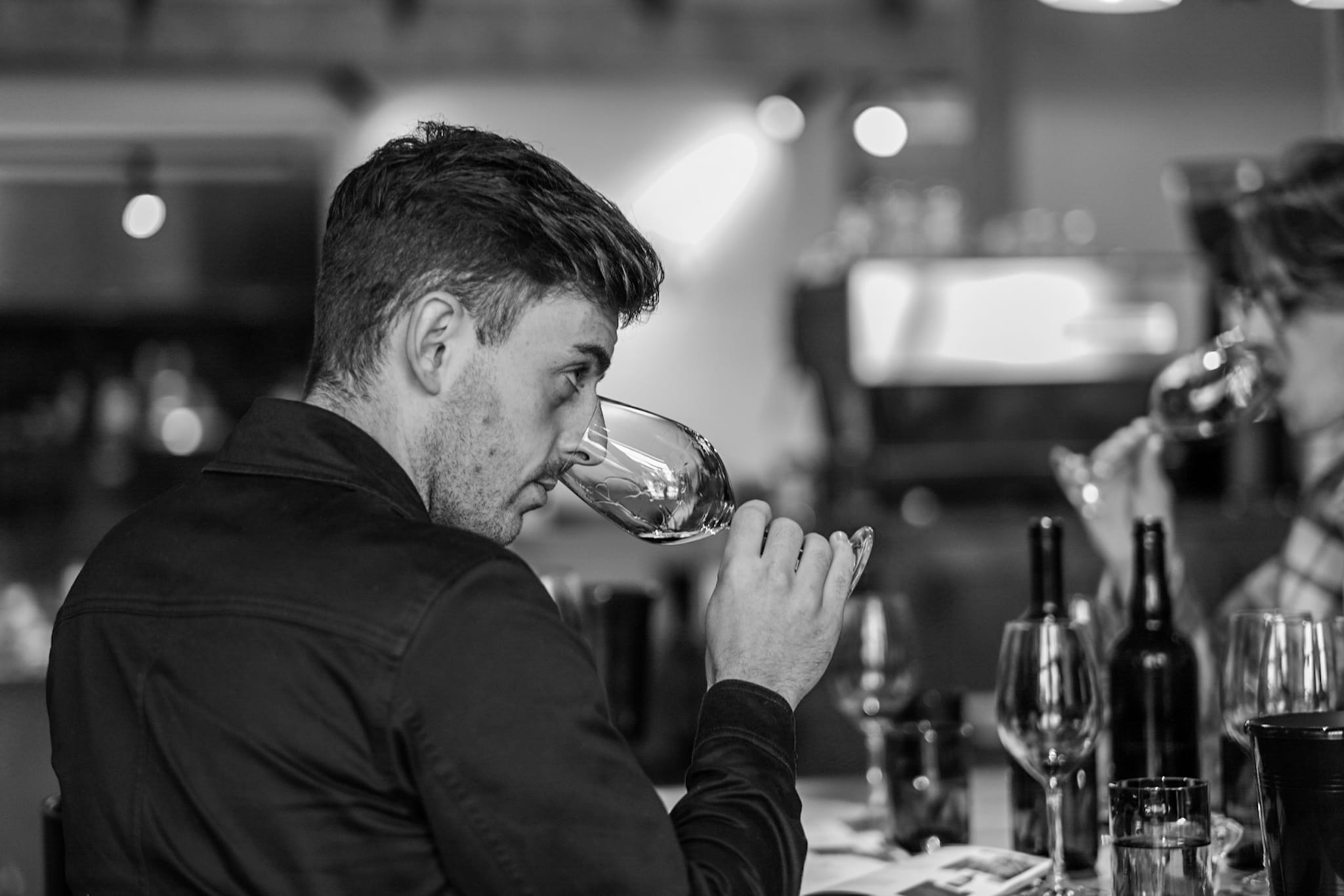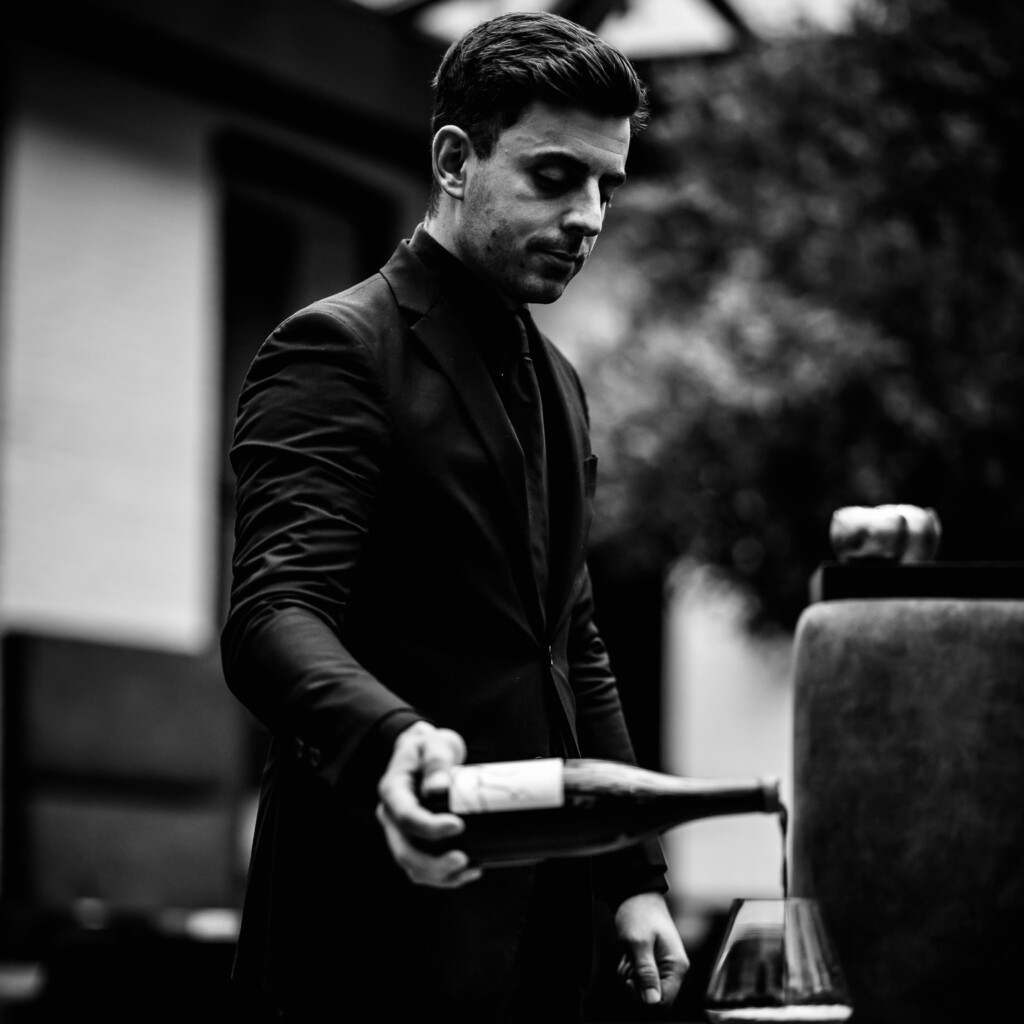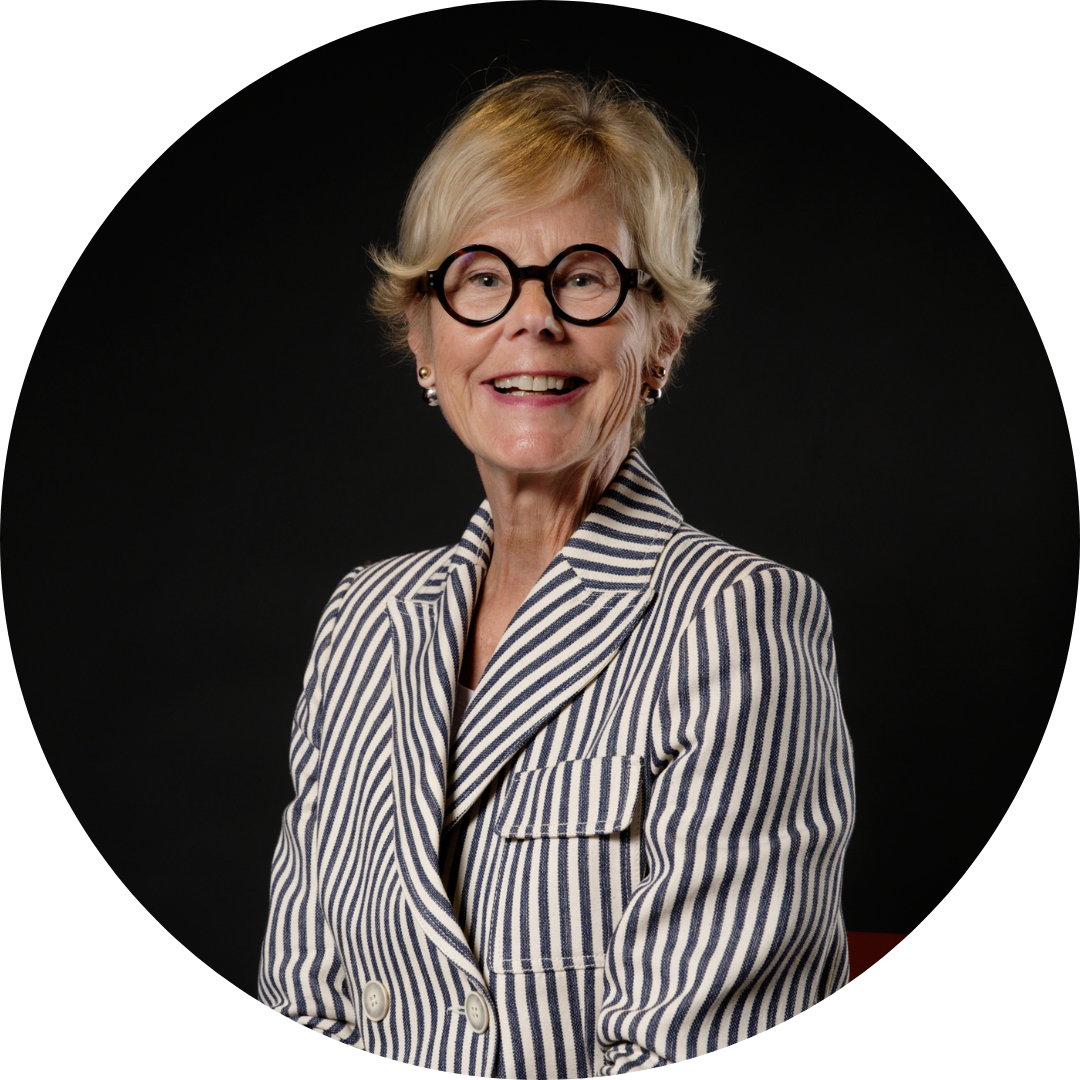Sem Beks
Head Sommelier Restaurant of Librije Zwolle, The Netherlands
Gerda: Can you share with us the origin of your passion for wine?
Sem Beks: I come from a hospitality (Horeca) family. Consequently, I ended up attending a hotel school. In the first year, I received lessons about wine, which I found very fascinating. It is indeed a very broad and diverse product. At that time, I was 17 and didn’t have a clear idea of what I wanted to do with my life. Through an internship, I got in touch with a classic Fine dining restaurant in South Netherlands called Château st. Gerlach. This fine-dining restaurant also had some vineyards. I interned at this restaurant and encountered an amicable sommelier – a great guy who knew a lot about wine and excelled in hospitality at the table. I found it very fascinating that you could combine these two aspects. Thanks to him, my appetite for wine knowledge has continued to grow. Subsequently, I started taking wine classes.
Currently, I am in the process of completing WEST 4. As for whether I want to become a Master of Wine…? No, acquiring wine knowledge should remain enjoyable. I don’t mean to say that pursuing a Master of Wine qualification wouldn’t be enjoyable, but I believe it would require sacrificing many things that bring me a lot of pleasure. I’m afraid doing so might diminish my passion for wine.
My thesis will focus on non-alcoholic wines. I’ve noticed an increasing demand for these wines in our restaurant as alcohol consumption decreases. I still wonder if these wines can distinguish themselves from regular wines, but that is a discussion point that we could talk about for hours.
G: What are the most rewarding and the most challenging aspects of your work daily?
Sem Beks: The most challenging aspect of my work is the constant focus on quality at De Librije, a three-Michelin-starred restaurant. Quality is at the core of everything we do, requiring ongoing vigilance and commitment. What I find particularly interesting and challenging is elevating my team, including Sara, my right hand, and two assistant sommeliers who started early 2023, to a high level of knowledge acquisition. They are all incredibly motivated.
Apart from my usual tasks such as tastings and adding wines to our menu, I am constantly searching for new suppliers of mature Bordeaux wines since I do not purchase wines “En Primeur.” In the current market situation, this is becoming increasingly challenging.
G: How do you stay in good shape?
Sem Beks: I aim to abstain from drinking four days a week. Maintaining my fitness is crucial, which is why I also engage in sports four days a week. It is essential due to the demanding nature of the work and constant movement. By taking good care of your body, you can continue practicing this wonderful profession in the long term.
Weekly, I set aside time to taste a selection of wines, sometimes even more. I travel across the country for tastings with specific themes that interest me, or we host importers with special selections. Blind tastings with the team, featuring wines from our cellar, are also a regular occurrence.
Relationship with wineries
Gerda: What are the most important factors for selecting wines for your wine list ?
Sem Beks: We only serve wines in which we have full confidence. Our selection procedures involve two different approaches: one for pairings and one for the wine list itself. For the wine list, we consider which wines are missing, which vintages are suitable, and which producers we would like to represent. For wine and food pairings, we aim for perfect harmony with the dishes we serve. We closely examine the chef’s menu: what ingredients and concepts does he use? When new dishes are introduced, we initially taste the first steps of these dishes with the owner, Thérèse Boer. Then, we start considering which wines to serve by first searching our archive. Afterward, we make a final selection where the price-quality ratio and our complete conviction behind these wines are essential. You won’t quickly find a robust, full-bodied American Zinfandel with us, as it doesn’t align with our cuisine, our style, and neither with our personal preferences.
G: How do you interact with wineries to select wines for your wine list?
Sem Beks: I do not maintain direct contact with various wine estates; all my communication goes through the importers. Our wine list has 800 references, and I try to visit the estates with which we have long-standing partnerships regularly, but unfortunately, it doesn’t always work out. Time always seems to be in short supply, and tasks continue to pile up. In 2023, I had the opportunity to visit Wachau, Burgundy (twice), the Mosel, Piedmont, and the Jura. I still aim to visit various wine regions and meet a wide range of producers around 5 to 6 times a year. It’s surprising, but I have never been to Bordeaux. This situation urgently requires a change, it’s long overdue.
G: Why haven’t you ever visited Bordeaux?
Sem Beks: We do not purchase “En Primeur,” opting instead to acquire Bordeaux ready-to-drink wines through multiple importers. Personally, connecting with different Châteaux owners/managers is not essential, partly due to the La Place de Bordeaux system. I attend the UGC tasting every year, which allows me ample opportunities to engage in discussions with many owners/managers.

Credit Photo: Pieter d’Hoop
Customers requirements
G: What are the most common expectations your customers have regarding wines and your expertise as a sommelier?
Sem Beks: Within our wine program, we host to two types of guests. On one hand, we have guests who enjoy being surprised, often inclined towards the wine pairing and seeking a perfect match between the menu and the wines. On the other hand, we welcome guests who are experienced drinkers, have developed specific tastes, and possess knowledge of wines, sometimes even maintaining an extensive personal wine cellar. For these customers, we select a variety of lesser-known wines to provide them with surprises. A wine list exclusively featuring wines from France, as beautiful as it may be, could potentially be too predictable. Our goal is to emphasize diversity, to teach our guests something new, and to provide an educational experience.
It’s fantastic to surprise a guest who claims to only drink white Burgundy with, for instance, a Chardonnay from America made in a way that closely resembles the Burgundian style. Moments like these are particularly beautiful; introducing guests to exquisite wines from less-known regions for them. It’s important to broaden their horizons while simultaneously meeting their expectations of top quality for the price they pay.
Equally essential is that our guests can taste wines with us that they may not easily find elsewhere. Although many wines, especially Bordeaux, are accessible on the private market, we aim to offer those unique, hard-to-find wines. This approach attracts people who specifically come to us to experience exceptional and uncommon wines.
G: is that also the drawback of Bordeaux, that our wines are too widely available?
Sem Beks: What I particularly appreciate about Bordeaux is that it is accessible to everyone, unlike, for example, Burgundy. However, this does require more creativity for us in compiling the wine list because many of our guests already have Bordeaux in their wine cellars.
Bordeaux wines
G: What is your opinion about Bordeaux wines?
Sem Beks: It is easier for me to obtain 12 bottles of Petrus than 12 bottles of Romanée Conti. Currently, the market revolves mainly around niche producers with very limited allocations, available only to the “happy few.” I see it as a positive development that Bordeaux wines remain accessible, even though they come with a price tag. This trend ensures that everyone can have access to these wines.
Since we do not buy “En Primeur,” another positive development in Bordeaux is that the top châteaux are releasing older vintages that are ready to drink, rather than releasing everything during the “En Primeur” period. Currently, we see many 2021 wines entering the market, but they are still too young for us. It’s nice to see that châteaux are holding back more wines. We can purchase Bordeaux wines that are ready to drink. The downside is that, even in Bordeaux, the prices of the Premiers Crus Classés have skyrocketed.
Ten years ago, we used to serve a Premier Cru Classé by the glass for a price of €100, and that was considered normal. These days, I find myself having to ask for a higher price for a glass, which often prompts reactions from our guests. They say, “I used to buy this wine when it was affordable. Now, I prefer to spend that money on a whole bottle at home.” This is something we see a lot now.
G: What strategies do you use to highlight lesser-known or underrated Bordeaux wines
Sem Beks: For a while, we served a beautiful Côtes de Castillon. A significant portion of our wines is available by the glass. I also did this for a while with Sociando Mallet 2005, perhaps not an unknown producer but one that has fallen somewhat into obscurity. Then, there was also the Champ de Treilles from Corinne et Jean-Michel Comme, of which I recently sold the last bottle from 2015. It was truly an exceptionally beautiful wine, always well-preserved with us. But how do you handle such situations? You must allow your guests to experience these wines. You need to take the risk of purchasing something and serving it to your guests. Ultimately, we all tend to be somewhat conservative and prefer the familiar taste of what we already know.
But if you dare to challenge your guests with a “give this a try, without telling you what it is,” followed by their feedback, which is positive nine times out of ten, then that’s a smart move. Our guests are definitely receptive to that. It’s all about the right argumentation when you approach the table. I don’t mean endlessly arguing why a wine should be enjoyed. The more the sommelier argues, the more it seems like he’s defending the wine and trying to make more of it than the wine actually is. But the truth is always in the glass. Just let people taste the wine and then hear what they think.
G: What should we do in Bordeaux to have a better representation on wine lists?
Sem Beks: I don’t think Bordeaux is doing anything wrong. It’s more that we in the hospitality industry should make more efforts to present the mid-range of Bordeaux. If you ask an average guest, “What do you think of Bordeaux?” they often say it’s expensive because they primarily think of the higher, costly segment. They forget that Bordeaux also produces excellent wines in another, more accessible segment. The image of Bordeaux as an expensive wine region often prevails.
G: What can we do to improve that image?
Sem Beks: I don’t have exact knowledge about marketing budgets in Bordeaux. There are tastings organized by various authorities there, but I believe these tastings should be more extensive. I recall a phenomenal tasting of Moulis Médoc that I attended, but it was too limited to one specific appellation. Bordeaux should organize these types of tastings on a broader scale. That would be the fastest way to achieve greater collaboration and to show sommeliers that Bordeaux has a comprehensive and diverse offering.

Tendancies
G: Are there current trends in the Netherlands, and if so, what are the most popular trends right now?
Sem Beks: In general, there is a greater desire for softer and refined wines. Ten years ago, people were still looking for powerful red wines with new oak. If the same question is asked today, it seems that people want a lot of juice and flavor, but not necessarily tannins. Tannins are often almost seen as something negative.
G: How do you stay up-to-date with ever-changing trends in the wine industry, and how does it influence your wine choices?
Sem Beks: I read many trade journals, follow various forums, and am active on social media. One of my regular reading habits includes going through the Nobel Rot, a British magazine that is both entertaining and informative. I participate in numerous tastings, visit wine producers, and also attend the UGC tastings organized in the Netherlands. During these events, there is room for questions, keeping me well-informed about developments in Bordeaux. I am influenced by well-substantiated arguments and convincing reasons that people present. If something is truly well-supported, I often think, ‘This definitely deserves my attention.
The wines
G: What advice would you give to young professionals aspiring to become high-level sommeliers like yourself?
Sem Beks: What is truly crucial is patience. In today’s times, we all strive to achieve the highest possible right after finishing our education and to be the very best. Knowledge and skills mainly come from practical experience, and this requires time. Additionally, keep tasting continuously and stay engaged in exploring new wines. It’s important to avoid getting stuck in a routine of ‘I’ve always done it this way, so it must always be this way.’ That’s a pitfall for many. Taking a year off is not an option, as you will quickly fall behind on developments. You must always stay involved in the field.
Passion for wine manifests in two different ways: inspiring guests at the table and sometimes spending a bit more for a beautiful bottle of wine. Tasting is important, but sharing a bottle of wine in good company is just as essential, and we must not forget that aspect of enjoyment.
G: What is the best way to taste?
Sem Beks: As few external stimuli as possible, good focus, in a calm environment, preferably in the morning.
G: What is your favourite grape variety?
Sem Beks: Oh, that’s a tricky question. It’s like asking a grandfather who his favorite grandchild is. Maybe I should say cabernet sauvignon or merlot, but I’ll choose riesling. With many grape varieties, you can find tremendous diversity, but with riesling, the interplay between residual sugar, acidity, and aroma is incredibly intriguing to me. You can find a beautiful riesling for €10, but also for €100 or even €500. It’s a specific grape that can be very enjoyable across a wide spectrum, even in a lower price range. What I particularly appreciate is the layering. In wines that have aged in wood, woody layers can develop, providing more strength and intensity. Riesling doesn’t need that. It’s exquisite, and refined, without being heavy; that’s what I find so beautiful about this grape variety.
G: What is your favorite wine?
Sem Beks: Egon Müller, Saar Kabinett from the 1980s. A wine of unparalleled class that can even give you goosebumps. I had a similar experience with a Haut Brion 1953 and a La Mission Haut Brion 1953 that I had the privilege of tasting side by side. Perhaps I had a slight preference for La Mission, but these are wines that will always stay with me. It was phenomenal. Such moments, however, are more common for sommeliers, like the first time I got to taste Petrus.
G: What is the best food pairing with a Bordeaux wine?
Sem Beks: I was in a restaurant with two other friends, and we ordered a simple main course. Perhaps it’s precisely that simplicity that makes it so beautiful. We enjoyed a perfectly cooked ribeye with a Mouton Rothschild 1996. It was one of the most beautiful pairings I have ever experienced with a Bordeaux wine. The setting, the atmosphere, everything was perfect at that moment, and that’s, of course, part of it as well.
Gerda BEZIADE has an incredible passion for wine, and possesses a perfect knowledge of Bordeaux acquired within prestigious wine merchants for 25 years. Gerda joins Roland Coiffe & Associés in order to bring you, through “Inside La PLACE” more information about the estate we sell.


